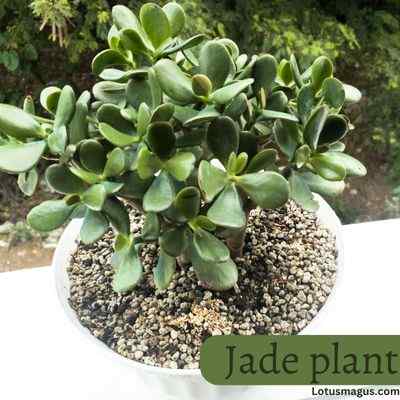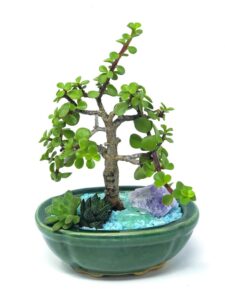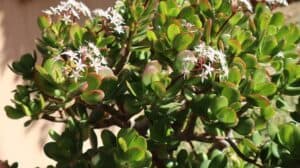Jade plants are attractive houseplants that offer foliage. After a period, your jade plant’s branches may become top-heavy. Don’t worry—jade plants often experience this! You can repair and avoid this problem. We’ll discuss why jade plant branches become top heavy, how to correct them, and how to keep them healthy in this piece. If your jade plant is top-heavy, continue on.
Is Your Jade Plant Top Heavy?
Your jade plant top may become heavy due to overwatering. Too much wet soil and excess water makes most branches droopy and top-heavy. It’s crucial to not overwater your jade plant and let the soil dry up between waterings.
What is the jade plant?
South African succulent Jade plant (Crassula ovata) is popular. It is a slow-growing, long-lived Crassulaceae plant. Jade plants have oval-shaped, thick, meaty leaves on woody stems. “Jade plant” comes from its glossy, jade-green leaves.
In warm areas, jade plants may thrive outside. They are simple to feed and water. They bring beauty to any house or yard with their winter white or pink blossoms. Jade plant owners often experience top-heavy branches that bend or break. now lets explain the problem and how to repair it.
Understanding the causes of top-heavy jade plant branches
Jade plants are attractive succulents that may grow tall and broad. Many jade plant owners worry about top-heavy branches that droop. Understanding why a jade plant has top-heavy branches will help you correct it.
- Overwatering causes Jade Plant Branches Top Heavy. Overwatering a jade plant makes its branches droopy and top-heavy. It’s crucial to not overwater your jade plant and let the soil dry up between waterings.
- Lack of sunshine causes top-heavy jade plant branches. In order to acquire adequate sunshine, jade plants may grow tall and thin. If your jade plant is top-heavy and has spaced leaves, it may require more sunshine.
- Finally, a top-heavy jade plant with yellowing or browning leaves may indicate root rot. Overwatering or inadequate soil drainage may cause root rot, weakening and top-heavy plants. To preserve your jade plant from root rot, act immediately.
Knowing what causes top-heavy jade plant branches lets you correct them and maintain your plant healthy. With careful maintenance, your jade plant may thrive and beautify your house for years.

| Specification | Description |
|---|---|
| Plant | Jade Plant (Crassula ovata) |
| Issue | Branches appear top-heavy and may droop or break |
| Causes | Overgrowth or poor pruning, uneven distribution of foliage, inadequate light or nutrients |
| Symptoms | Branches appear thicker and heavier near the top of the plant, and may bend or break under the weight of leaves |
| Treatment | Prune back overgrown branches, redistribute foliage evenly, provide better light and proper nutrients, support plant with stakes or ties |
| Prevention | Prune plant regularly to maintain shape, provide adequate light and avoid overwatering or underwatering |
| Environment | Native to South Africa, but widely cultivated as a houseplant or outdoor plant |
| Appearance | Succulent plant with thick, fleshy leaves and woody stems |
| Light Requirements | Bright, indirect light or filtered sun exposure |
| Water Requirements | Infrequent watering, allowing soil to dry out between waterings |
| Soil Requirements | Well-draining soil with a pH of 6.0 to 7.5 |
| Maintenance | Minimal maintenance required, occasional fertilization to promote growth, prune to maintain shape |
Signs and symptoms of top-heavy branches
Jade succulents may grow tall and top-heavy. Top-heavy branches may cause many plant problems. As they fight to hold the leaves and stems, branches often lean or bow. In extreme instances, branches may break off.
Jade plants with top-heavy branches have wrinkled or drooping leaves. The plant lacks water and nutrients to maintain the branches. If the problem is not treated, the leaves may become yellow or brown and fall off.
If your jade plant exhibits any of these symptoms, support the branches to avoid additional harm. This may require anchoring the plant with a bamboo rod to support the branches or cutting down top-heavy growth to disperse weight. Your jade plant should recover and flourish with proper care.

Prevention tips: How to avoid top-heavy branches
Avoiding jade plant top-heavy branches is the greatest approach to prevent problems. Tips to prevent this issue:
- Prune periodically to keep your jade plant healthy and short. Use sharp pruning shears to trim long or top-heavy jade plant branches.
- Support your jade plant to avoid top-heavy branches. As it develops, support it with a stout pole or trellis. To prevent bending and breaking, attach the branches to the support using garden rope.
- Water properly: Overwatering might make your jade plant top-heavy. Water your plant just when the soil is dry and never let it sit in water.
- Give jade plants bright, indirect sunshine. Your plant may grow overly tall and top-heavy without adequate light. Your jade plant needs bright, indirect sunshine all day.
Follow these techniques to maintain your jade plant healthy and avoid top-heavy branches.

How to fix top-heavy jade plant branches
To avoid breakage, take action if your jade plant’s limbs are top-heavy and bending over. Pruning the plant may help. Remove leaning branches and stems using clean, sharp pruning shears. Cut the stem at 45 degrees for good development.
Branch support may help a top-heavy jade plant. Tie the branches to a stake at the plant’s base. This will assist spread branch weight and avoid breakage.
Repot your jade plant in a bigger container with new dirt. This will allow the plant to grow roots and branches. Use a well-draining soil mix and water well after repotting.
Top-heavy jade plants need protection. To avoid top-heavy branches, water and fertilize your plant regularly.

Pruning the jade plant for a balanced shape
A healthy jade plant requires pruning. Pruning promotes new growth, removes dead branches, and shapes your plant. Jade plant pruning requires clean, sharp pruning shears.
Then, find the top-heavy branches. To promote growth, remove or clip these branches. Just prune one-third of the plant’s leaves every session. This prevents plant stress and death.
Cut jade plants above leaf nodes. This will stimulate branch growth. Avoid cutting too near to the main stem to prevent plant damage and disease.
Remove dead or damaged jade plant branches frequently. This prevents sickness and promotes development. Brown or black branches without leaves are dead.
Frequent trimming keeps jade plants healthy and well-shaped. During the plant’s active growth season, spring and summer, prune. With little trimming and care, your jade plant will flourish and beautify your house for years.
Repotting the jade plant to promote root growth
Repot your jade plant if its branches are top-heavy and ready to fall over. Repotting your plant in a new container with fresh soil promotes root development and plant health.
- Repot your jade plant in a slightly bigger container. This allows roots to develop and prevents root-bound plants.
- Water your plant well before repotting to soften the soil. Carefully remove the plant from the old container and untangle the roots. Clean, sharp scissors or pruning shears remove dead or damaged roots.
- Fill the new container 1/3 with fresh dirt. Put your jade plant in the middle of the container and push dirt around the roots to remove air pockets. To help your freshly potted jade plant acclimate, water it well and set it in bright, indirect light for a few days.
Repotting too often might stress and shock your jade plant. To keep your jade plant healthy, just repot as needed and use fresh, well-draining soil.
Steps to take to ensure the jade plant remains healthy
While durable and low-maintenance, jade plants need some attention to be healthy. If your jade plant’s branches are top-heavy, take actions to keep it healthy.
- Start with repotting. Jade plants that are top-heavy may have outgrown their pots. Its roots will expand and stabilize in a bigger pot.
- Adjust the plant’s watering. Overwatering makes branches top-heavy, while underwatering weakens and droops the plant. Water the jade plant only when it’s absolutely dry.
- Finally, give the jade plant ample sunshine. Jade plants need bright, indirect light. The plant might grow weak and top-heavy without adequate light.
- Also prune frequently. Pruning removes damaged branches and promotes new growth. This keeps the plant healthy and prevents top-heaviness.
These measures will keep your jade plant healthy and robust with balanced branches.
Common mistakes to avoid when caring for jade plants
Many plant enthusiasts choose jade plants because they’re gorgeous and low-maintenance. Even with minimum upkeep, jade plants may make blunders that harm their health and attractiveness. Avoid these jade plant blunders.
- Overwatering jade plants is a typical error. Succulent jade plants conserve water. Overwatering causes root rot and plant death.
- Low light: Jade plants flourish in bright, indirect sunshine. Leggy plants lose their compact structure due to lack of light.
- Poor drainage: Jade plants require well-draining soil to avoid water buildup in the container. Roots might decay without appropriate drainage.
- Temperature fluctuations: Jade plants dislike unexpected temperature swings. Avoid drafts.
- No pruning: Jade plants need trimming to be healthy and look good. Top-heavy branches might shatter if not pruned.
Avoid these blunders to keep your jade plant healthy and gorgeous for years. With appropriate maintenance, your jade plant will provide delight and beauty to your home or business.
Conclusion: Final tips for caring for your jade plant
I hop you get the answer on “Jade Plant Branches Top Heavy” and as you know jade plant maintenance is enjoyable and gratifying so do it often. Follow these methods to keep your jade plant healthy for years.
Overwatering your jade plant might cause root rot and other problems. Plant your plant in well-draining soil.
Give your jade plant plenty of sunshine, but avoid direct sunlight for long periods. To prevent top-heavy growth, trim your plant.
Lastly, watch for pests and illnesses and respond quickly that will surely make your jade plant healthy and thriving.
Also read related article on Jade plant:
Jade Plant Cannot Support Itself – Main Causes Why It Falls?
Jade Plant Meaning – Symbolism(Spiritual), Feng Shui
6 Amazing Benefits of Jade Plant, Uses(Superstition, Feng Shui)
Are Jade plant Toxic to Cats? – Humans, Dogs(Is It Safe)
